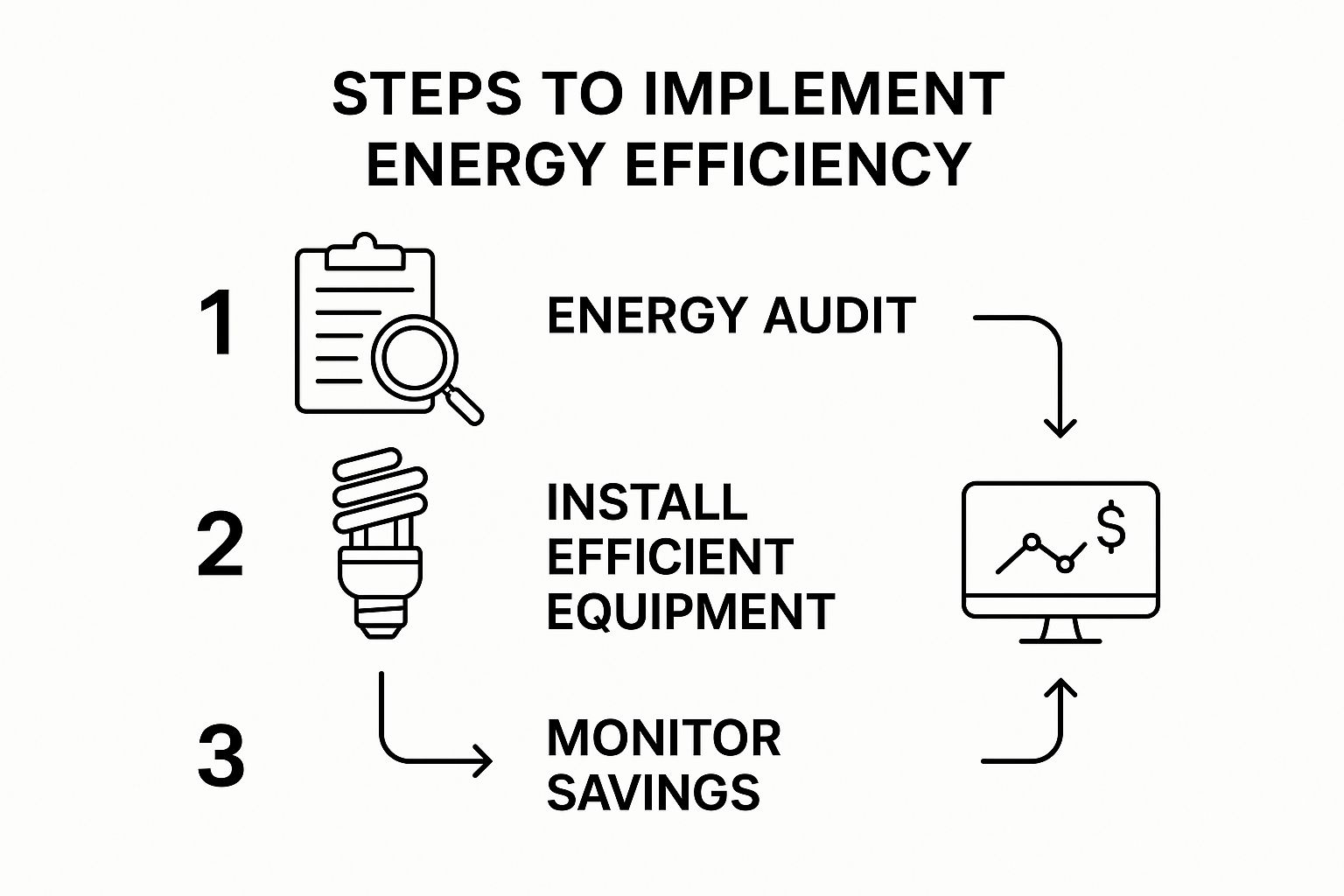Cutting operational costs isn’t just about trimming the fat. It’s about mastering your processes, using technology smartly, and building a team culture where every dollar is spent with purpose. This guide gets straight to the point, offering a real framework to turn cost management from a defensive chore into your secret weapon for growth.
The Real Playbook for Slashing Operational Costs
Forget the old slash-and-burn approach. Modern cost reduction is a strategic game of efficiency, not sacrifice. It’s about wringing more value out of what you already have, automating the repetitive tasks that drain your team’s energy, and using data to spot financial leaks before they turn into floods.
This isn’t about those frustrating, across-the-board budget cuts that kill innovation. Instead, we’re talking about making smart, targeted improvements that actually boost productivity and fatten your bottom line. Think of it as your roadmap to turning intelligent spending into a powerful competitive advantage.

A Modern Framework for Cost Efficiency
To really move the needle, you need an approach that hits on three core areas at once: your processes, your tech, and your people. Each one supports the others, creating a solid foundation for long-term financial health.
This table breaks down the three fundamental pillars of modern cost reduction. Each one is a critical piece of the puzzle.
Core Pillars of Modern Cost Reduction
| Pillar | Primary Focus | Key Outcome |
|---|---|---|
| Process Optimization | Identifying and eliminating waste, bottlenecks, and redundant steps in daily workflows. | Increased team productivity and faster delivery cycles. |
| Technology & Automation | Implementing tools that automate manual tasks and provide a single source of truth for data. | Reduced human error and more time for strategic, high-value work. |
| Cost-Conscious Culture | Empowering every team member to identify and suggest cost-saving opportunities. | Sustained financial discipline and continuous improvement from the ground up. |
By focusing on these three areas together, you build a resilient system where efficiency is the default, not an afterthought.
We’re going to get practical here and focus on using agile tools like monday.com integrated with Jira. This connection is a game-changer for bridging the communication gaps between technical and business teams—a notorious source of hidden costs and delays. When you create that single source of truth, you kill redundant work and expensive mistakes for good.
The goal is to build a system where efficiency just happens. When your tools and processes are in sync, your teams can stop fighting fires and wrestling with clunky workflows. That shift alone can unlock some serious savings.
This guide will give you a concrete plan for:
- Spotting the Leaks: Learn how to map out your processes to find the bottlenecks and resource drains that are quietly costing you money.
- Automating the Grunt Work: Use tools to get rid of manual data entry and all those repetitive admin tasks nobody wants to do.
- Building a Savings Mindset: Empower every single person on your team to contribute to the company’s financial health.
When you focus on these pillars, you’re not just cutting expenses. You’re building a sharper, more productive, and more profitable organization from the inside out.
Find Your Financial Leaks with Process Mapping
You can’t fix a problem you can’t see. Before you can slash operational costs, you need a crystal-clear picture of where your time, money, and energy are actually going. Think of yourself as an inefficiency detective—your first job is to map out the entire crime scene, which is your team’s day-to-day workflow.
This isn’t about creating some overly complex chart that gets filed away and forgotten. The goal is to make your processes tangible, so you can finally put your finger on the frustrating bottlenecks and wasteful steps that are quietly bleeding your budget dry.
Visualize Your Workflows from Start to Finish
At its core, process mapping is just drawing a picture of how work gets done. It follows a task on its journey from the starting pistol to the finish line, showing every handoff, decision point, and potential delay in between. A visual approach like this makes points of friction jump right off the page.
A classic example I see all the time is the handoff between a development ticket in Jira and a related project task in monday.com. How many emails, Slack messages, or quick sync-up meetings does it take to get those two systems on the same page? Mapping this out often reveals a costly communication chasm where projects grind to a halt and deadlines get pushed.
This is where teams often uncover shocking amounts of wasted time. I worked with a marketing agency that mapped its client reporting process and was stunned to find team members were burning a combined 20 hours per week just manually pulling data and slapping it into slide decks. Once they saw the workflow laid out visually, the inefficiency was undeniable. They quickly moved to an automated solution and reclaimed all that time, almost overnight.
Process mapping turns vague complaints like “things feel slow” into concrete, solvable problems. It forces you to confront the messy reality of your workflows and gives you a clear target for improvement.
Pinpointing the Most Expensive Bottlenecks
Once you have your process map, the financial leaks often become glaringly obvious. You’re hunting for specific patterns of waste that are inflating your operational costs.
Keep an eye out for these usual suspects:
- Redundant Data Entry: Are your people entering the same information into multiple systems? Every duplicate entry is a waste of precious time and a prime opportunity for errors to creep in.
- Approval Delays: Where do tasks get stuck waiting for a sign-off or a decision? These hold-ups can trigger a domino effect, stalling entire projects.
- Manual Handoffs: How does work get passed between teams? If the process relies on someone remembering to send an email or a Slack message, it’s a breakdown just waiting to happen.
- Information Silos: Do team members have to go on a scavenger hunt for information across different platforms? Every minute spent searching is a minute not spent doing valuable work.
A software team, for instance, used this technique to put their QA cycle under the microscope. They found a simple but expensive gap: developers working in Jira had zero visibility into the specific testing checklists the QA team was using in monday.com. This blind spot led to constant rework and a bloated testing timeline. By connecting the two platforms to create a shared view, they cut their QA cycle time by nearly 30%.
Start with a Simple Whiteboard Sketch
You don’t need any fancy software to get rolling. In fact, some of the most powerful business process mapping techniques start with nothing more than a whiteboard and a pack of sticky notes. The most important thing is to get the people who actually do the work in the room—they know the real story, warts and all.
This simple infographic outlines a similar three-step approach used in energy efficiency, which applies perfectly here.

The visual nails it: effective change starts with an audit (mapping your process), then you implement a solution (like an integration), and finally, you monitor the results to make sure you’re actually getting the savings you were after. By taking the time to map everything out, you’re no longer guessing where the problems are. You’re gathering the cold, hard evidence needed to make smart, targeted changes that will have a real impact on your bottom line.
Using Technology to Spend Smarter, Not Harder
When you’re trying to get a handle on operational costs, technology should be your secret weapon, not just another line item on the budget. The real magic happens when you stop throwing more software at problems and start making your existing tech stack actually work together. Smart integration and automation are where you’ll find some serious savings.
The goal here is to kill off the small, repetitive tasks that quietly bleed hours from your team’s week. Just think about the time someone spends manually copying updates from a developer’s ticket in Jira over to a project board in monday.com. It’s not just slow; it’s a perfect recipe for expensive human errors and project delays.
Bridge the Gap Between Development and Project Management
One of the most expensive leaks in any company is the communication breakdown between technical and non-technical teams. Developers live and breathe in Jira, while project managers and stakeholders are tracking the big picture in hubs like monday.com. When those two worlds don’t speak the same language automatically, you pay for it in lost productivity and blown deadlines.
Connecting these platforms isn’t a “nice-to-have”—it’s a non-negotiable for any business that’s serious about cutting operational waste. A solid integration creates a single source of truth, which means an update in one system is instantly mirrored in the other.
This kind of integration hits several critical targets at once:
- It kills redundant work: No more manual data entry or copy-pasting status updates.
- It cuts down on human error: Automatic syncing means no more typos or forgotten updates that can throw a project off course.
- It gives everyone real-time visibility: From the CEO down to the developer, everyone sees the same, up-to-the-minute information.
You can even see how a monday.com board can be embedded right inside a Jira issue, giving everyone immediate context without having to switch tabs.
This visual link keeps project context and development tasks perfectly aligned, stopping the kind of misunderstandings that lead to costly rework.
Embrace the Cloud to Cut Infrastructure Overhead
Another huge opportunity for savings is hiding in your server closet. On-premise servers are expensive. It’s not just the initial purchase; you’re constantly paying to maintain, power, and cool them. For a lot of businesses, this is a massive and inflexible operational cost.
Moving to the cloud is one of the most powerful IT cost reduction strategies you can make. When companies switch from pricey on-premise hardware to cloud platforms like AWS, Microsoft Azure, or Google Cloud, they slash expenses tied to server maintenance, energy bills, and hardware upgrades. Most cloud services run on a pay-as-you-go model, which makes resource allocation far more efficient and flexible.
A software startup I know did exactly this. They ditched their on-premise servers and went all-in on a flexible cloud solution. The move saved them over $30,000 annually in hardware, maintenance, and energy costs, and it gave them the power to scale their resources up or down on demand.
Beyond Software Stacks and Servers
When you’re thinking about spending smarter with technology, don’t stop at software and servers. Look at areas like energy consumption. For businesses looking for creative ways to save, implementing energy-efficient technology solutions can lead to some surprisingly big savings on operational costs. This could be anything from smart thermostats in the office to more efficient equipment on a factory floor.
The principle is the same no matter where you apply it: use technology to fundamentally change how you operate, not just to do the same old things a bit faster. By integrating your core platforms, moving to the cloud, and even optimizing your energy use, you can transform technology from a cost center into a powerful engine for efficiency.
You can learn more by checking out our guide on IT cost reduction strategies.
Fine-Tune Your Team and Vendor Relationships
Your people and partners are your biggest assets, but let’s be honest—they’re also some of your biggest expenses. Digging into the human side of cost savings isn’t about pinching pennies until your team’s morale hits rock bottom. It’s about building a smarter, more efficient ecosystem around your business.
When roles and responsibilities get fuzzy, you’re basically paying for confusion. Overlapping tasks, redundant work, and projects falling through the cracks are all symptoms of a poorly defined structure. The first move is to make sure everyone knows exactly what they own, what they’re responsible for, and how their work plugs into the bigger picture.

This kind of clarity immediately highlights where communication breaks down. Often, the gaps between departments—like the handoff from sales to product or from development to support—are where the most expensive problems hide. Our guide on breaking down silos offers some practical steps to get your cross-functional collaboration on track.
Master the Art of Smart Outsourcing
Not every task has to be handled by your in-house team. Smart outsourcing is a powerful way to cut down operational costs. It lets you delegate the non-core functions so your team can zero in on what they do best: driving revenue and innovation.
Think about the work that’s essential but doesn’t directly contribute to what makes your company unique. These are prime candidates to hand off:
- Admin Work: Things like bookkeeping, payroll, and data entry can almost always be handled more cost-effectively by specialized firms.
- IT Support: Instead of a full-time IT department, many businesses save a bundle by outsourcing network management and help desk support.
- Specialized Marketing: Need a one-off video production or a deep dive into SEO? Hiring an expert agency is often cheaper than trying to build that talent in-house.
The key is to see outsourcing not just as a cost-cutting move, but as a strategic way to access specialized skills on demand.
Turn Vendor Management into a Profit Center
Your vendors should feel more like partners, not just line items on an expense report. Proactive vendor management can unlock some serious savings that are often hiding in plain sight right inside your existing contracts. You just have to start the conversation.
I know a small e-commerce business that did exactly this. They took a hard look at their top three software licenses and realized they were paying for a ton of features they never used. By simply renegotiating their contracts to better fit their actual needs, they saved over 15% on their annual tech spend. That’s real money that went straight back into their marketing budget.
Treat your supplier negotiations like a partnership. The goal isn’t to squeeze every last penny out of them. It’s to find a mutually beneficial arrangement where you get the absolute best value for your investment.
To get started, try these tactics:
- Consolidate Your Suppliers: Are you buying similar things from multiple vendors? Bundling your purchases with a single supplier can give you the leverage to negotiate some major volume discounts.
- Review Contracts Annually: Never, ever let a contract auto-renew without a review. Markets change, your needs evolve, and new competitors pop up. Use this as a chance to benchmark pricing and terms.
- Explore Longer-Term Agreements: If you have a trusted vendor you plan on working with for the long haul, ask about discounts for signing a multi-year contract. They get predictable revenue, and you get locked-in savings.
By getting your team structure right and actively managing your vendor relationships, you can cut operational costs in a big way—without making painful sacrifices. It’s all about working smarter, not just cheaper.
How to Build a Cost-Conscious Company Culture
One-off cost-cutting projects are like crash diets—they might work for a minute, but they rarely stick. If you want sustainable savings that actually last, you have to weave financial awareness directly into your company’s DNA. This is how you shift from a top-down mandate to a collaborative, bottom-up movement where every single employee becomes a champion for efficiency.
But let’s be real, true cultural change doesn’t happen in a single all-hands meeting. It’s built through consistent actions, genuine transparency, and the right kind of motivation. When people understand the why behind the need to cut operational costs, they’re far more likely to get on board and bring their best ideas to the table.

Make Budget Transparency the Default
You can’t expect your team to care about a budget they can’t even see. Secrecy just breeds apathy. The very first step is to pull back the curtain on spending and give department leads genuine ownership over their numbers.
This is where a shared platform like monday.com becomes a game-changer. You can build high-level dashboards that visualize departmental spending against targets in real time. When a team lead can see their budget health at a glance, they’re empowered to make smarter decisions on the fly, instead of waiting for a scary month-end report from finance.
This approach does two critical things at once:
- It builds ownership: When leaders see the direct impact of their team’s spending, they naturally start thinking more strategically.
- It fosters trust: Transparency shows you trust your team to be responsible partners in the company’s financial health.
Incentivize and Celebrate Efficiency Wins
What gets rewarded gets repeated. It’s that simple. If you want your team to actively hunt for savings, you need to make it worth their while. Go beyond a simple “thank you” in a meeting and create a formal system for recognizing and rewarding brilliant, cost-saving ideas.
Your frontline employees often have the best view of where waste happens. A developer might know about an underused software license, or a project manager might see a workflow ripe for automation. Creating a channel for these ideas is like opening up dozens of new eyes to find savings.
Set up a simple “Cost-Saving Idea” board in monday.com where anyone can drop in a suggestion. Then, create a clear reward structure. This doesn’t have to be a massive cash prize—it could be a bonus, extra vacation days, or a budget for team development.
The key is to publicly celebrate the wins, showing everyone that their contributions are seen and valued. This is a fantastic way to improve workflow efficiency and get your team actively involved. For a deeper dive, check out our guide on how you can improve workflow efficiency.
Empower Department Leads to Own Their Spending
Finally, a cost-conscious culture thrives on autonomy. You have to give your department leads the authority to manage their own budgets within clear guidelines. This empowers them to act like mini-CEOs of their own domains, making agile decisions that benefit both their team and the company’s bottom line.
When a team lead is responsible for their own P&L, they start asking smarter questions. Do we really need this new subscription? Can we achieve this goal with the tools we already have? This mindset shift is the ultimate goal, turning cost management from an annual chore into a daily habit.
Common Questions About Reducing Operational Costs
Jumping into a cost reduction initiative can feel like stepping into a minefield. You know you need to do it, but every move feels risky. Will it tank morale? Will you cut the wrong thing? Let’s tackle some of the most common questions that pop up, giving you the clear answers you need to move forward with confidence.
Where Do I Even Start When Trying to Reduce Operational Costs?
Feeling overwhelmed is completely normal. The trick is to avoid trying to boil the ocean and instead focus on gathering some solid intel first. The best place to begin is with a thorough audit of your largest and most frequent expenses.
Don’t just look at the big-ticket items, though. Pay close attention to recurring costs like software subscriptions, utilities, and departmental spending. The real breakthrough, however, often comes from mapping your core business processes to find the hidden inefficiencies that are quietly draining your budget.
Look for the low-hanging fruit where you can make an immediate impact:
- Redundant Tools: Are you paying for three different tools that essentially do the same thing? A quick software audit can uncover some surprising overlaps.
- Manual Data Entry: Where are your teams spending hours just copying information from one system to another? This is a prime target for automation.
- Process Bottlenecks: Where do projects seem to constantly get stuck? Pinpointing these delays often uncovers a deeper operational issue that’s costing you money.
Start small. Prove the return on investment with a quick win, and then use that momentum to take on the bigger challenges.
How Can I Cut Costs Without Hurting Employee Morale?
This is the million-dollar question, and it’s a critical one. The secret is to frame the entire initiative as a quest for efficiency and smart spending, not just “cost-cutting.” The language you use matters—a lot.
Get your team involved from the very beginning. The people on the front lines doing the work every day often have the most brilliant insights into what’s wasteful. Ask them for ideas on how to make their jobs easier, faster, and less frustrating.
When your team sees that changes are about eliminating tedious, soul-crushing tasks—not eliminating jobs—morale doesn’t just survive, it thrives. Freeing people up from grunt work so they can focus on more strategic, engaging projects is one of the best morale boosters there is.
Create a system to formally recognize and reward cost-saving suggestions. Be completely transparent about the “why” behind the changes. When you explain that this is all about strengthening the company’s financial health, which secures jobs and creates new opportunities for growth, you get buy-in.
What Are the Most Overlooked Areas for Cost Savings?
It’s easy to focus on obvious expenses like rent or salaries, but the biggest savings are often hiding in plain sight. Many businesses completely overlook the “soft” costs and small, recurring expenses that quietly add up over time.
One of the most significant yet ignored areas is the cost of inefficient processes and poor communication. Just think about the cumulative hours lost to:
- Unnecessary meetings that could have been an email.
- Fixing errors that stemmed from a simple miscommunication.
- Manually re-entering the exact same data into multiple systems.
This wasted time is a massive, invisible operational drain.
Another sneaky culprit is “subscription creep”—that slow accumulation of SaaS tools that are underutilized, redundant, or completely forgotten about. A regular audit of your software licenses can yield thousands of dollars in easy savings. Finally, don’t ignore things like energy consumption or minor supply chain inefficiencies. Small, consistent improvements in these areas can lead to substantial long-term savings.
How Do I Measure the Success of My Cost Reduction Efforts?
Success isn’t just about watching your expense line go down. A truly successful initiative improves the business as a whole. You have to track both financial and operational metrics to really get the full picture.
The obvious financial metric is the direct reduction in your operating expense (OpEx). But that only tells part of the story.
You should also be tracking metrics that reflect new efficiency gains:
- Time-to-Completion: How much faster are key projects being delivered?
- Error Rates: Has the number of mistakes or the need for rework dropped?
- Productivity: Are you seeing a higher output per employee or per team?
- Customer Satisfaction: Are happier customers a byproduct of smoother internal processes?
For technology integrations, you can measure the reduction in manual hours spent on reporting and status updates. It’s also vital to track key service desk metrics like ticket resolution times, which often improve dramatically when underlying processes are fixed. Set clear benchmarks before you start and track these KPIs on a shared dashboard. This gives you a complete, 360-degree view of your success.
Ready to bridge the gap between your teams and slash operational costs for good? resolution Reichert Network Solutions GmbH offers the seamless integration between monday.com and Jira that you need. Eliminate manual work, create a single source of truth, and empower your teams to work smarter. Get started with monday.com for Jira today.
